
French postcard by Croissant, Paris, no. 3664. Photo: Film Pathé. Publicity still for Le chemineau/The Tramp (Albert Capellani, 1905), based on the first part of Victor Hugo's novel 'Les misérables'. Jean Valjean is granted lodging by the parish priest of a village, steals several silver candlesticks but escapes arrest thanks to the false testimony of the priest.

French postcard by FC & Cie, no. 86/2. Photo: A. Bert. Marcelle Géniat in 'Le Roi s'amuse'. French stage and screen actress Marcelle Géniat (1881-1959) made her film debut in Le roi s'amuse/The King Amuses Himself (Albert Capellani, 1909) as Blanche opposite Paul Capellani as the king and Henry Sylvain as Triboulet. The following decade, an Austrian film version was made, Der König amüsiert sich (Jakob Fleck, Luise Fleck, 1918) starring Hermann Benke as Rigoletto and Liane Haid as his daughter, Blanche. Another adaptation of Hugo's play is the Italian film Il re si diverte/The King's Jester (1941) which starred Michel Simon as Rigoletto and Rossano Brazzi as the king.

German postcard by Ross Verlag, no. 105/1. Photo: Universal Pictures Corp. Conrad Veidt as Gwynplaine and Mary Philbin as the blind Dea in The Man Who Laughs (Paul Leni, 1928), based on Hugo's 1869 novel 'L'homme qui rit'. The Man Who Laughs is a romantic melodrama similar to films such as The Hunchback of Notre Dame. The film is known for the grim Joker-like grin on Gwynplaine's face and is often classified as a horror film. Film critic Roger Ebert stated, "The Man Who Laughs is a melodrama at times even a swashbuckler, but so steeped in expressionist gloom that it plays like a horror film." 'L'homme qui rit' had been filmed twice before. Wikipedia mentions a French Pathé version, L'Homme qui rit (1909) of which no copies are known to survive, and the Austrian film company Olympic-Film released a German version, Das grinsende Gesicht/The Grinning Face (Julius Herska, 1921).

French postcard by A.N., Paris, no. 936. Photo: Pathé Natan. Harry Baur as Jean Valjean in Les Misérables (Raymond Bernard, 1934), based on the novel by Victor Hugo. For six months in 1933, the shooting took place in Paris and the South of France. Because of its length, the film was released in two parts. It became Harry Baur’s best-performed film performance and some say the best film interpretation of Hugo’s famous character. His costars were Charles Vanel as Javert and Josseline Gael as Cosette. Because of the European success, Baur received Hollywood offers but declined. He didn’t want to leave Paris.

East-German postcard by VEB Progress Film-Vertrieb, Berlin, no. 2/72. Photo: Gina Lollobrigida as beautiful Romani street dancer Esmeralda in Notre Dame de Paris/The Hunchback of Notre Dame (Jean Delannoy, 1956). The film also stars Anthony Quinn as Quasimodo and Alain Cuny as Frollo. Hugo's Gothic novel 'Notre-Dame de Paris'(1831) details the story of Quasimodo, the disabled bell-ringer of Notre Dame, as he struggles to stand up to his ableist guardian Claude Frollo, who also wants to commit genocide against Paris' Romani population. The novel has been described as a key text in French literature and has been adapted for films over a dozen times, such as a 1923 silent film with Lon Chaney, a 1939 sound film with Charles Laughton, and a 1996 Disney animated film with Tom Hulce.
The Battle of Hernani
Victor Marie Hugo was born in Besançon, France, in 1802. He was the third son of Joseph Léopold Sigisbert Hugo, a French general under Napoleon's empire from Lorraine, and Sophie Trébuchet, originally from Nantes. Due to his father's profession, Hugo had a difficult childhood and was dragged from town to town by garrison life. Hugo stayed in Paris, in the old monastery des Feuillantines, in Naples, where his father was governor of a province for a while, and in Spain, where his father governed three provinces. Moreover, Hugo's parents were on bad terms with each other and had different political and religious views.
Hugo's mother lived apart from her husband from 1813 onwards and went to live with her son in Paris. On the advice of his father, Hugo went to the Lycée Louis-le-Grand, but it was mainly his mother, a Catholic royalist, who influenced his education and that of his two brothers, Abel and Eugène. It is therefore not surprising that themes such as 'faith' and 'monarchy' appear frequently in Hugo's early work. Hugo made his vocation as a writer known quite early when, at the age of fourteen, he wrote in his diary, "Je veux être Chateaubriand ou rien." (I want to be François René de Chateaubriand or nothing).
At the age of 15, he already received recognition for his poetry from the Académie française. In 1820, he founded with his brothers the literary magazine Le Conservateur littéraire, thus attracting early literary attention. He won the competition of the Académie des Jeux Floraux in Toulouse, of which he was also the laureate the following year. Hugo abandoned his studies of mathematics and threw himself entirely into his literary career. In 1822 his first book of poetry appeared, 'Odes'. Several more books of poetry would follow. In 1824, the collection 'Nouvelles Odes et Poésies diverses' appeared, which earned him a royal allowance from Louis XVIII. However, it was the collection 'Odes et Ballades' (1828), that made him famous. In 1827, he took part in Le Cénacle, a literary circle around writer Charles Nodier that met in the Bibliothèque de l'Arsenal and can be considered the cradle of French Romanticism. He met François René de Chateaubriand, Théophile Gautier, Alfred de Musset and Alfred de Vigny, among others. His participation in this group also meant that he moved to the liberal camp.
In 1822, Hugo married Adèle Foucher, with whom he had been in love since 1819. The marriage also aroused jealousy in his brother Eugène, who would gradually fall prey to insanity. The couple had five children: Léopold (1823), who died a few months after his birth, Léopoldine (1824), Charles (1826), François-Victor (1828) and Adèle (1830). Of these five children, only Adèle would survive her father, although her unstable mental health meant that she often stayed in nursing homes. In the year after his marriage, Hugo published his first novel, the horror novel 'Han d'Islande'. His second novel, 'Bug-Jargal', followed three years later.
From the end of the 1920s, Hugo can be considered the leader of the Romantic Cénacle. He was also attacked and vilified in that capacity by the supporters of academism. Moreover, Hugo also clashed with the censors because of the boldness of some of his plays. His 1829 drama 'Marion de Lorme' was initially banned by the censors because it painted an unflattering picture of the French monarchy. In 1827, he published the never-staged verse drama 'Cromwell', which gained notoriety for its preface in which Hugo attacked the classical rules, including the unity of time and of place. The preface thus enjoyed the reputation of a manifesto of the Romantic movement.
The big fuss came with the premiere of Hugo's play 'Hernani' in 1830, which is largely forgotten today, except as the basis of Giuseppe Verdi's opera of the same name. 'Hernani' can be considered an important stage in the history of French theatre. The second performance is known as 'la bataille d'Hernani' (The Battle of Hernani). Hugo had already had to defend his play verse by verse to the royal censors and fragments had been leaked to the press, intended to ridicule the work and its author. On the evening of the second performance, Hugo had invited many of his friends (Balzac, Gautier, de Nerval, etc.) to counter the representatives of the classical theatre. The play almost provoked revolts between the opposing camps: classicists versus romantics, republicans versus royalists, and liberals versus conformists. In the theatre, the battle was won by Hugo's supporters, but the press denounced the play. The following performances were still rather unsettled, but the play booked full houses each time. Hugo had succeeded in bringing the romantic innovation, which until then had mainly enthused salon insiders, to the people on stage.
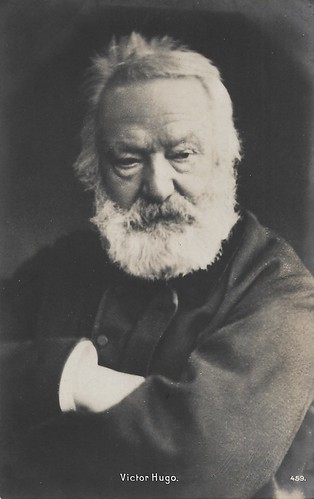
Possibly Belgian postcard, no. 459. Photo: Studio Nadar. The card was mailed in 1912 in Belgium.
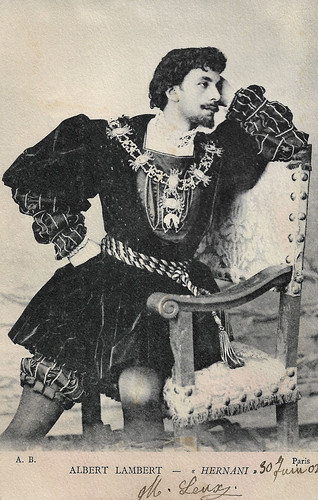
French postcard by A.B. Photo: Albert Lambert in a stage production of 'Hernani' by Victor Hugo. Sent by mail in 1902. Albert Lambert (1865-1941) acted in many plays by Victor Hugo. He entered the reputed Comédie-Française in 1885 with his part in 'Ruy Blas' by Hugo. In 1905, he played Didier in 'Marion Delorme'. His performance was so popular, that he repeated it in 1922. In 1934 he also performed at the London Cambridge Theatre in the lead of Hugo's 'Ruy Blas' (1934).
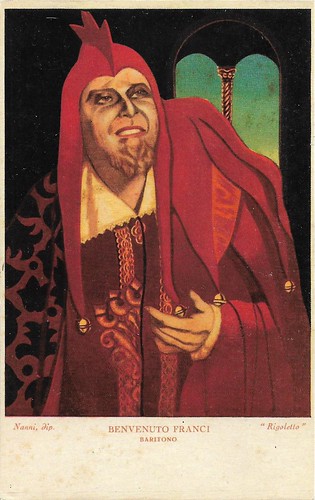
Italian postcard. Artwork by Nanni. Benvenuto Franci in the opera 'Rigoletto'. Although Hugo was not keen on having adaptations of his work set to music, there are several operas based on his work. A famous example is 'Rigoletto' by Giuseppe Verdi (1851), based on 'Le Roi s'amuse'. The Italian baritone Benvenuto Franci (1891-1985) sang Rigoletto in 1931 at Covent Garden in London.

French postcard by Croissant, Paris, no. 3664. Photo: Film Pathé. Publicity still for Le chemineau/The Tramp (Albert Capellani, 1905), based on the first part of Victor Hugo's novel 'Les Misérables'. Unclear is who the actors are, but the sets were by Hugues Laurent. The film appeared in the 'Scènes dramatiques et réalistes (8ème Série)' by Pathé.
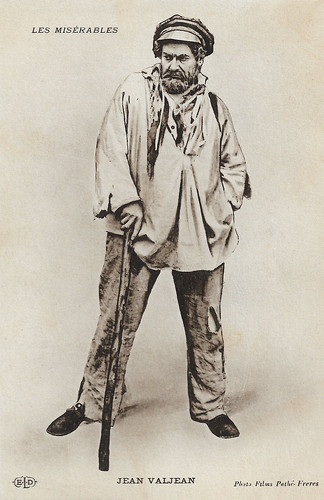
French postcard by ELD. Photo: Films Pathé-Frères. Henry Krauss in Les Misérables (Albert Capellani, 1913). Sent by mail in 1916. French actor and director Henry Krauss (1866-1935) became a star with his interpretations of two characters from novels by Victor Hugo. In 1911 he starred as Quasimodo in Notre Dame de Paris/The Hunchback of Notre-Dame (Albert Capellani, 1911) opposite Stacia Napierkowska as Esmeralda, and in Les Misérables (Albert Capellani, 1913), he was Jean Valjean, relentlessly pursued by justice.
A true national hero
Victor Hugo's next play was 'Le roi s'amuse'(1832), which was banned by the censors after one performance because of its open mockery of the French nobility. However, the play became a success in written form. Hugo was so enraged by the ban that he wrote his next play, 'Lucrèce Borgia', in just two weeks. This play was first performed in 1833 and was a great success. Mademoiselle George, a former mistress of Napoleon, played the leading role. Another role was played by the actress Juliette Drouet. Drouet became his muse and mistress and, although Hugo had several romantic escapades during his lifetime, this relationship was recognised and tolerated as quite special even by his wife. Drouet was given the opportunity to play the role of Lady Jane Grey in Hugo's play 'Marie Tudor' (1833), but after the first performance was deemed too light and replaced. She then stopped acting and devoted herself until her death in 1883 to her lover as an unpaid secretary and travelling companion.
In 1835, Hugo's play 'Angelo' successfully premiered. In 1838, it was the turn of 'Ruy Blas'. That play was the first to be performed at the Théâtre de la Renaissance, the new theatre founded by the Duke of Orléans, a brother of King Louis-Philippe and an admirer of Hugo's work, to stage new plays. Although it is considered to be one of Hugo's best pieces, it was only met with moderate enthusiasm at the time. It would be 1843 before Hugo produced another piece. 'Les Burgraves' ran for 33 nights but lost an audience to a rival play. It would be the last play Hugo wrote. He would write another short verse drama in 1869, 'Torquemada', but this was never intended to be performed and was not published until a few years before his death in 1882.
Hugo's first full-fledged novel, 'Le dernier jour d'un condamné' (The Last Day of a Condemned Man), appeared in 1829 and already showed the social conscience that would later shine through in many of his works. In 1831, Hugo's first major novel was published: 'Notre Dame de Paris' (The Hunchback of Notre Dame). The work was so successful that it was soon translated into several European languages. In 1834, the documentary novella 'Claude Gueux' was published, telling the story of a real-life murderer being executed in France. This short story would later be regarded by Hugo as a precursor to his immense work on social inequality, 'Les Misérables'. The first steps towards this novel were probably taken around 1830, but it would take until 1862 before the book was completely finished and could be published.
After the coup d'état of Napoleon III, the critical Hugo was threatened with arrest and went into exile in Guernsey. He found new inspiration in his new surroundings and published several famous pamphlets against Napoleon III, such as 'Napoléon le Petit' (The Little Napoleon) and 'Histoire d'un crime' (History of a Crime), in which he condemned Napoleon III's coup d'état on moral grounds. During his stay in Guernsey, he also wrote some of his best works. He published three widely acclaimed books of poetry: 'Les Châtiments' (1853), 'Les Contemplations' (1856) and 'La légende des siècles' (1859-1883). He also published the famous novel 'Les Misérables' (1862). Well aware of the high standard of his work, Hugo decided to award the publication to the highest bidder. That was the Belgian publishing house Lacroix and Verboeckhoven, which sent out press releases six months before publication and launched an unprecedented marketing campaign.
His novel 'Les Travailleurs de la mer' (1866) was dedicated to the island of Guernsey and was well received. In it, Hugo described man's constant struggle against the sea and the creatures living in it. In 1869, the novel 'L'Homme qui rit' was published, which once again tied in with the political and social criticism of 'Les Misérables'. The novel presented a critical image of the aristocracy. However, the novel was not as successful as its predecessor and Hugo himself noticed the distance that was developing between himself and literary contemporaries such as Flaubert and Zola, whose naturalistic novels surpassed his in popularity.
In 1870, Victor Hugo returned to France after Napoleon III was defeated by Prussia at the Battle of Sedan and the Third French Republic was proclaimed. His return to Paris was triumphant. He was received as a true national hero. During the last years of his life, he published 'Religions et religion' (1870) on the limits and possibilities of science, 'L'année terrible' (1872) a poetic commentary on the Commune), his last novel 'Quatre-vingt-treize'(1873) about the Terror after the French Revolution, 'L'Art d'être grand-père' (1877) and 'Les Quatre Vents de l'esprit' (1881). Victor Hugo died in 1885 at the age of 83. His death gave rise to national mourning. His coffin stood for several days under the Arc de Triomphe, from where it was transported to its final resting place in the Panthéon amid massive interest. It is estimated that some three million people paid their last respects.

German postcard by Verlag Ross, Berlin, no. 1093/4, 1927-1928. Photo: Paramount-Film. Director Herbert Brenon and Pola Negri during the shooting of the silent film The Spanish Dancer (1923), based on Hugo's popular character of Don César de Bazan, created for his drama 'Ruy Blas'(1838). The Spanish Dancer tells the love story between Don César de Bazan (Antonio Moreno) and the beautiful Gypsy dancer and fortune teller Maritana, played by Pola Negri.
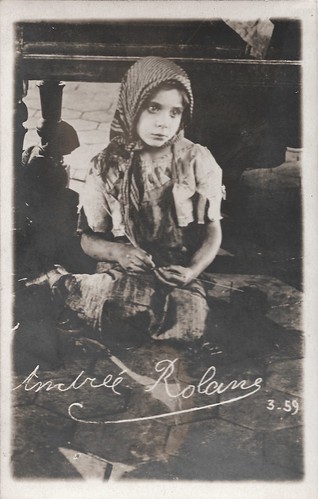
French postcard, no. 3.59. Andrée Rolane as Cosette in Les Misérables (Henri Fescourt, 1925). Andrée Rolane debuted at a very young age as young Cosette in Henri Fescourt's silent version of Les Misérables (1925), with Gabriel Gabrio as Jean Valjean.
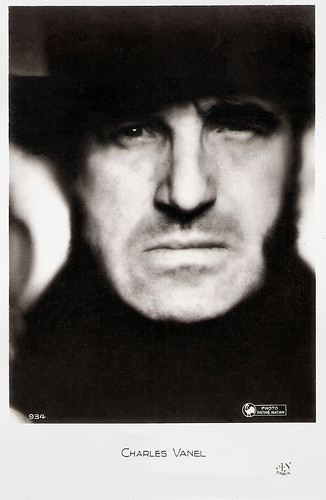
French postcard by A.N. Paris, no. 934. Photo Pathé Natan. Charles Vanel as Javert in Les Misérables (Raymond Bernard, 1934).
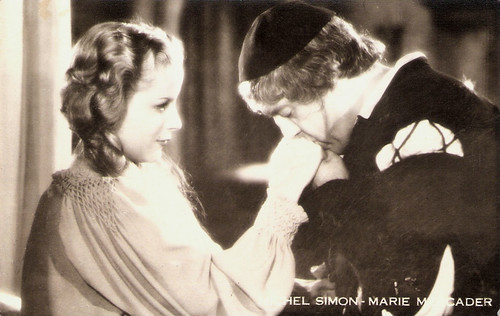
Italian postcard. Photo: María Mercader and Michel Simon in Il re si diverte/The King's Jester (Mario Bonnard, 1941), based on Hugo's novel 'L'homme qui rit'.
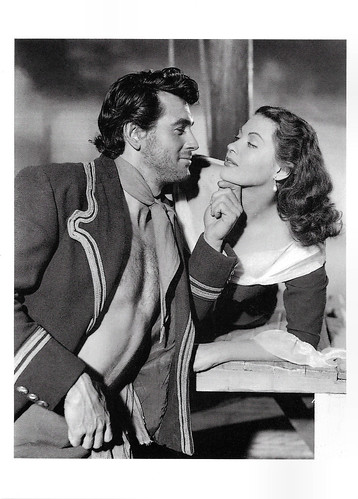
Swiss-German-British postcard by News Productions, Baulmes / Filmwelt Berlin, Bakede / News Productions, Stroud, no. 56493. Rock Hudson as Gilliat and Yvonne De Carlo as Droucette in Sea Devils (Raoul Walsh, 1952), produced by Coronado (RKO). Sea Devils is based on Hugo's 'Les Travailleurs de la mer' (1866). Rock Hudson stars as Gilliat, a jailed fisherman/smuggler who is offered a pardon if he undertakes a mission to sail to France to rescue Droucette, an English agent whose cover has been blown, and who has now been jailed. Gilliat accepts the challenge.
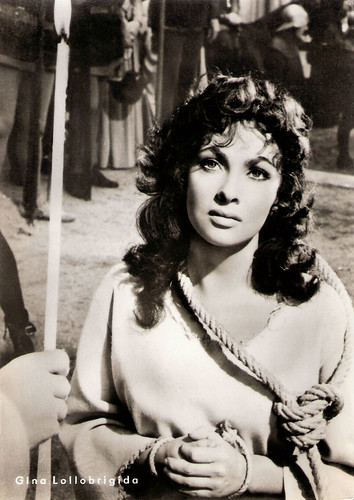
East-German postcard by VEB Progress Film-Vertrieb, Berlin, no. 56/72. Photo: Gina Lollobrigida in Notre Dame de Paris/The Hunchback of Notre Dame (Jean Delannoy, 1956).
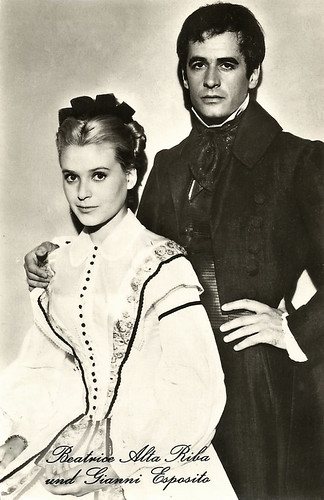
East-German postcard by VEB Progress Film-Vertrieb. Photo: DEFA. Béatrice Altariba as Cosette and Gianni Esposito as Marius in Les Misérables (Jean-Paul Le Chanois, 1958).
Sources: Wikipedia (Dutch and English), and IMDb.
No comments:
Post a Comment